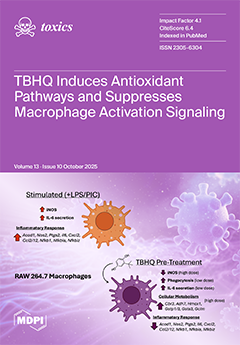Mercury exposure has been linked to male infertility. Given that mercury chloride (HgCl
2) may promote an oxido-inflammatory milieu associated with pathophysiological derangements, it is hypothesised that Thymoquinone (TQ), an antioxidant and anti-inflammatory agent, may mitigate the gradual harmful effects of mercury exposure on rat testes, epididymis, and hypothalamus, as these organs are vital to reproductive function. To test this hypothesis, 40 rats (strain: Wistar; sex: male) were randomly assigned to five cohorts of eight rats each. After a 7-day acclimation, treatments were dispensed for 28 consecutive days accordingly: Cohort I: distilled water only, as control; Cohort II: HgCl
2 only (20 µg/mL); Cohort III: TQ only (2.5 mg/kg); Cohort IV: HgCl
2 + TQ (20 µg/mL + 2.5 mg/kg); and Cohort V: HgCl
2 + TQ (20 µg/mL + 5 mg/kg). Co-treatment with TQ preserved the body and organ weight of the HgCl
2 exposed animals. However, TQ did not reduce HgCl
2-induced dysfunction in sperm function and morphology. The serum follicle-stimulating hormone (FSH), luteinising hormone (LH), and testosterone were increased significantly (
p < 0.05) by TQ co-treatment, while decreasing the prolactin level. TQ administration also increased (
p < 0.05) testicular enzymes, including alkaline phosphatase (ALP), lactate dehydrogenase (LDH), acid phosphatase (ACP), and glucose-6-phosphate dehydrogenase (G6PD) activities, which HgCl
2 decreased. TQ administration increased (
p < 0.05) HgCl
2-induced decreases in catalase (CAT), superoxide dismutase (SOD), glutathione peroxidase (GPx), glutathione (GSH), glutathione-
s-transferase (GST), and total sulfhydryl group (TSH) levels in the testes, epididymis, and hypothalamus of experimental rats. Further, TQ reduced HgCl
2-mediated increases in RONS-reactive oxygen and nitrogen species; LPO–lipid peroxidation; PC–protein carbonyl formation; and XO–xanthine oxidase activity. Furthermore, levels of inflammatory biomarkers, including tumour necrosis factor alpha (TNF-α), nitric oxide (NO), interleukin-1 beta (IL-1β), and myeloperoxidase (MPO), were decreased (
p < 0.05) in the co-treated groups, with a higher dose of TQ (5.0 mg/kg) showing a more pronounced protective effect. Additionally, TQ co-administration increased Bax and decreased Bcl-2 and p53 protein levels (
p < 0.05), thereby protecting the rats’ testes, epididymis, and hypothalamus from HgCl
2-induced apoptosis. Molecular docking simulation analysis revealed TQ interaction dynamics with PPAR-α and PPAR-δ to suppress NF-kB-mediated pro-inflammatory sequela as well as activate Nrf-2-mediated antioxidant defence system. These predicted biological effects of TQ resonate with the findings from the in vivo studies. Therefore, supplementation with TQ may help reduce chemical-induced toxicities, including HgCl
2‘s reproductive toxicity.
Full article






